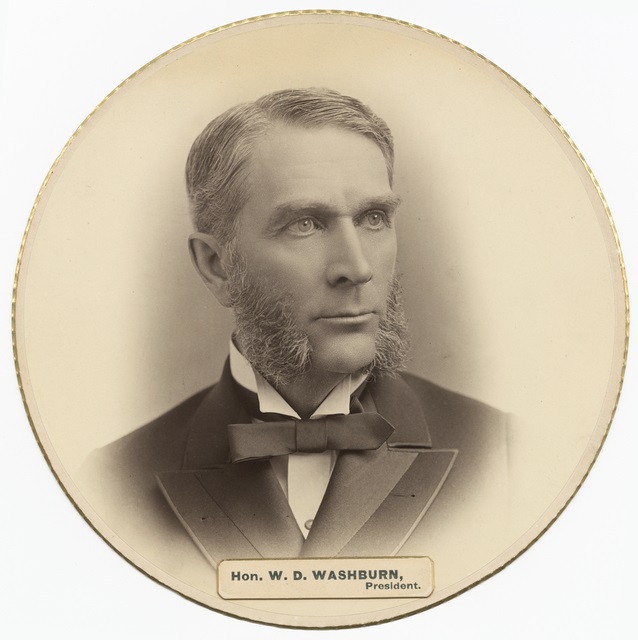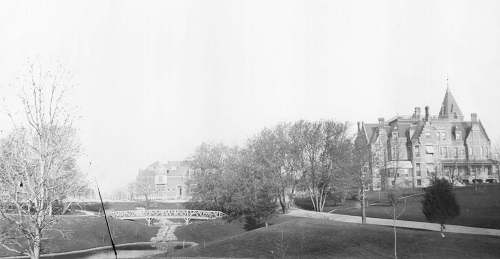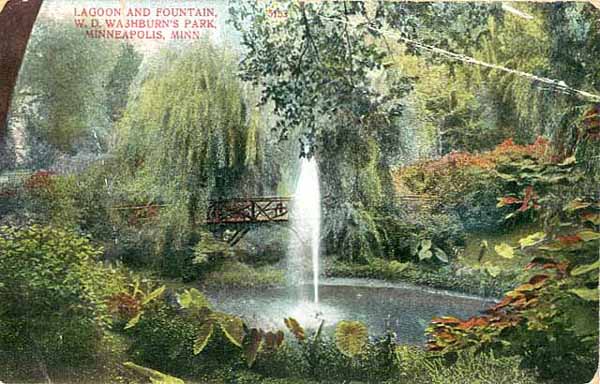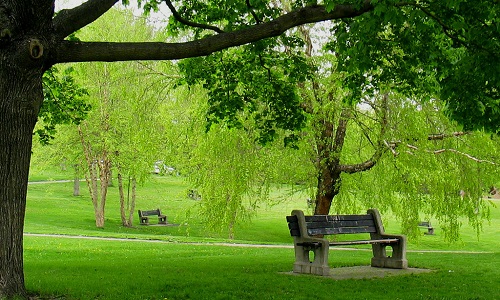Washburn Fair Oaks
 Sunday, March 10, 2019 at 1:04PM |
Sunday, March 10, 2019 at 1:04PM |  Michael Rainville Jr |
Michael Rainville Jr | Article by Michael Rainville, Jr.
Nestled right in the heart of a part of town that features some of Minneapolis’ oldest and most stunning architecture, Washburn Fair Oaks Park is a place of natural beauty that complements the historic and artistic beauty found in the museums around it.
 A portrait of William D. Washburn from 1880The story of this park starts back in 1857 when a lawyer from Maine by the name of William D. Washburn moved to Minneapolis to help his brother Cadwallader run his mill, the Minneapolis Milling Company. During the next two decades, he and his brother would help establish the milling industry in Minneapolis while also perusing his passion for politics. In 1871 he was elected to the Minnesota House of Representatives, in 1878 he was elected to the US House of Representatives where he served for six years, and in 1888 he was elected to the US Senate where he also served for six years.
A portrait of William D. Washburn from 1880The story of this park starts back in 1857 when a lawyer from Maine by the name of William D. Washburn moved to Minneapolis to help his brother Cadwallader run his mill, the Minneapolis Milling Company. During the next two decades, he and his brother would help establish the milling industry in Minneapolis while also perusing his passion for politics. In 1871 he was elected to the Minnesota House of Representatives, in 1878 he was elected to the US House of Representatives where he served for six years, and in 1888 he was elected to the US Senate where he also served for six years.
Once the 1880s got started, Washburn had become one of the wealthiest people in the state. In 1883 he decided to build his home among his colleagues and friends in what is now the Washburn-Fair Oaks Mansion District. Designed by Edward Townsend Mix, who also designed the old Metropolitan Building that was demolished in 1961, William Washburn’s mansion was accompanied by gorgeous landscaping, an artificial pond and footbridge, a greenhouse, and a carriage house. His estate was spectacular to say the least. Washburn named his property the “Fair Oaks Estate” after the 10-acre oak grove that stood on the land before he purchased it.
 Photo of the estate taken from 3rd Avenue facing west, Washburn's mansion is on the right.
Photo of the estate taken from 3rd Avenue facing west, Washburn's mansion is on the right.
 The artificial pond, 1910
The artificial pond, 1910
 He was also very fond of the Minneapolis Park system and intended to give his property to the Minneapolis Park Board once he passed away. In 1911, the property immediately south of his estate, the Villa Rosa owned by Dorilus Morrison, the first mayor of Minneapolis, was donated by Morrison’s son to the city with the intention to build an art museum on the site. Eventually, the Villa Rosa made way for the Minneapolis Institute of Art. This gave William Washburn the idea to offer his land to the Park Board. The deal was that the city would only pay the appraised amount of the land, and not the land and its buildings. This was a huge deal because Washburn’s buildings were valued at roughly $400,000, or over $10.5 million in today’s dollars. He sold the land to the Park Board for $250,000, or $6.6 million today, with the condition that he and his wife could reside there for as long as they lived. The land officially changed hands in 1915 when his wife passed away.
He was also very fond of the Minneapolis Park system and intended to give his property to the Minneapolis Park Board once he passed away. In 1911, the property immediately south of his estate, the Villa Rosa owned by Dorilus Morrison, the first mayor of Minneapolis, was donated by Morrison’s son to the city with the intention to build an art museum on the site. Eventually, the Villa Rosa made way for the Minneapolis Institute of Art. This gave William Washburn the idea to offer his land to the Park Board. The deal was that the city would only pay the appraised amount of the land, and not the land and its buildings. This was a huge deal because Washburn’s buildings were valued at roughly $400,000, or over $10.5 million in today’s dollars. He sold the land to the Park Board for $250,000, or $6.6 million today, with the condition that he and his wife could reside there for as long as they lived. The land officially changed hands in 1915 when his wife passed away.
Once the Park Board acquired the land, they tore down the greenhouse and stables but the left the mansion standing as it was used as a meeting place for local groups. During the next decade or so there were many ideas for the park. In 1917, Park Board President Theodore Wirth suggested installing a 1,100-seat amphitheater. Wirth also suggested to build a children’s playground on the site, but the neighbors were not fond of that idea. Meanwhile, the mansion was quickly falling into disrepair and becoming a hazard for the children who were playing in the park, so the neighbors offered to give the Park Board $25,000, or $368,000 today, to buy a new park where a playground and ball courts could be installed. They accepted this deal and in 1924 the Fair Oaks mansion was razed, and two years later, Clinton Field Park was created just a few blocks away.
After the mansion was brought down, the initial idea for the park was to make it into a landscaped plaza that lead up to the Minneapolis Institute of Art, and it would also serve as the head of an esplanade that would extend a mile north to the Minneapolis Auditorium, which is now the Convention Center. Just think if that project happened. We would have our own version of the Tuileries Garden to lead up to our own version of the Louvre. How glorious would that be?
 The park today
The park today
Nevertheless, this plan never got started, and instead the park turned into a peaceful place to take a break from the bustling city. If you’ve never visited this park, I highly recommend it. The next time you make a trip to the Minneapolis Institute of Art or the Hennepin History Museum, take a stroll through Washburn Fair Oaks Park. Sit on a bench and imagine how life might have been like in this part of Minneapolis in the 1880s and 1890s with towering mansions and marvelous landscaping. This city’s passion for parks can be traced back to before the city even started, and it is because of patrons of the arts and parks like William Washburn that we have so many breathtaking parks spread throughout the Mill City.
- - - - - - - - - - - - - - - - - - - - - - - - - - - - - - - - - - - - - - - - - - - - - - - - - - - - - - - -
 About Michael Rainville, Jr.
About Michael Rainville, Jr.
A 6th generation Minneapolitan, Michael Rainville Jr. received his B.A. in History from the University of St. Thomas, and is currently enrolled in their M.A. in Art History and Certificate in Museum Studies programs.
Michael is also a lead guide at Mobile Entertainment LLC, giving Segway tours of the Minneapolis riverfront for 6+ years.
He can be reached at mrainvillejr@comcast.net.
